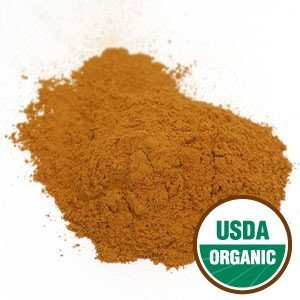Shop our Store!
Cinnamon Powder, Ceylon (Sweet) (Organic)
Bulk Herbs: Ceylon (Sweet) Cinnamon Powder (Organic)
Cinnamomum verum
Format: Powder
Size: 1 oz package
Also known as: Cinnamomum zeylanicum, True Cinnamon, Sweet Cinnamon, and Ceylon Cinnamon
Farming Type: Organic
Origin: Sri Lanka
The quest for cinnamon was one of the major factors that led the Europeans to explore the world in the 15th century. Cinnamon’s value during this time cannot be overstated. In the 1st century C.E., Pliny the Elder wrote that 350 grams of cinnamon was equal to 5 kilograms of silver, or about 15 times the value of silver per weight. Cinnamon comes from the Laurel tree, a tropical evergreen that grows in low altitudes and needs a moist, hot climate in which to thrive. Cinnamon bark comes in sticks, or quills. When peeled from the tree, they naturally roll up, and are then threaded on a string and air dried indoors, as direct sunlight would dry them out too quickly and they would lose flavor.
The difference between sweet cinnamon and cassia cinnamon is quite apparent; sweet cinnamon quills will have a layered look to them, as if several were rolled together, while cassia will appear as one thick piece of bark. Sweet cinnamon is also lighter in color, and as the name implies, of a sweeter flavor. Cinnamon quills have a long, almost indefinite shelf life, while cinnamon powder will lose its flavor over time. Sweet cinnamon can contain up to 4% oil of cinnamaldehyde, eugenol, and trans-cinnamic acid, however it is usually lighter in oil content and sweeter tasting than Cassia Cinnamon. It also contains phenolic compounds, tannins, catechins, calcium, iron, mucilage, resin, natural sugars, and traces of coumarin. Due to its incredible value, sweet cinnamon was used for centuries as a spice of the aristocracy and the wealthy.
During the middle ages it was used as a meat preservative due to its anti-bacterial and anti-fungal qualities, but also so that it could mask the stench of “aged” meats much better than salt. When choosing cinnamon for your own use, be forewarned that the quills of cassia are next to impossible to grind, the flavor usually being extracted by boiling. Sweet cinnamon quills are much easier to use in any recipe and quite easy to grind for use. Most everyone knows the virtues of uses cinnamon in baking, but there are a great many other uses that are being rediscovered, or invented everyday.
Cinnamon sticks are used in some cocktails as a stick to stir the drink, as well as being added to a traditional mulled wine recipe. Middle Eastern and Asian recipes make liberal use of cinnamon in their main dishes, curries, stews, biriyanis, and as a marinade for beef and lamb. A cinnamon tea also makes a wonderful digestive aid after dinner, and cinnamon sticks can even be used in pickling as something new to spice up an old recipe.
NOTE: It has been noted by the German Commission E that some people are in fact allergic to cinnamon, with side effects ranging from an allergic skin reactions to mucosa. It is not recommended for medicinal uses during pregnancy or breastfeeding.
For educational purposes only This information has not been evaluated by the Food and Drug Administration. This information is not intended to diagnose, treat, cure, or prevent any disease.

